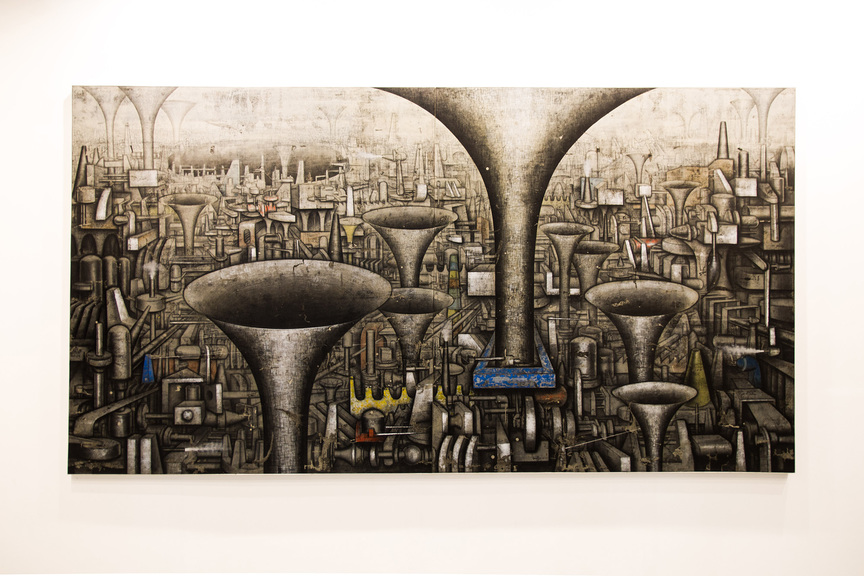
R
E
V N
E
X
T
SHANTHAMANI MUDDAIAH creates a striking work that is at once organic and formally precise in Fire Script (2018), presented at the booth of Gallery Sumukha (Bengaluru).
The 11th edition of India Art Fair (IAF)—the foremost platform for modern and contemporary South Asian art—took over New Delhi from January 31 to February 3. In terms of presentation and layout, the 2019 iteration was generally more considered than in 2018, and, for the most part, was free of the garish spectacle-pieces that often find their way into art fair booths. With 75 participating galleries compared to 78 in 2018, there were fewer dealers displaying their wares, but the proportion from South Asia and the number of South Asian artists represented was greater than ever, supporting IAF’s claim that it champions the region and its growing market. Fair director Jagdip Jagpal—now in her second year at the helm—even went so far as to say at the preview that one of her team’s biggest worries was that too much space was being given to Indian galleries—presumably in excess of the 70 percent that they had originally committed to.
While it’s true that Indian galleries were prevalent, these were not exclusively from New Delhi and Mumbai. Exhibitors from elsewhere had a strong showing, with Kolkata’s Experimenter Gallery enjoying a particularly good start, reportedly selling most of their works within the first few hours of the preview. In addition to participants from Dhaka, Kyoto, London and New York, international newcomers included Kyoto’s Sokyo Gallery, and Berlin’s Neugerriemschneider, the latter of which brought IAF its first piece by Ai Weiwei, as well as works by other big names such as Olafur Eliasson. They reported a promising first few hours, with interest coming from both familiar European buyers and new collectors from the region.
The buzz around the international stars at Neugerriemschneider was not louder than that generated by home grown talent, both old and new. IAF continued its longstanding tradition of exhibiting local modern artists. However, in 2019, the likes of DAG and Dhoomimal Galleries and their offerings from artists like FN Souza, Raja Ravi Varma and Ram Kumar, were more separate from the contemporary art presentations that took up the majority of the fair’s space, perhaps suggesting a new confidence that contemporary practices from the region are now sufficiently established, and do not require association with better known modernists to generate footfall.
As in past years, the 2019 IAF comprised a variety of sections in addition to the main Galleries portion, as well as a dense program of supplementary attractions. This year’s “Focus”—which sees participating galleries and institutions curate individual artist showcases—had projects from the likes of Bhagyashree Suthar with Akara Art, Prajjwal Choudhury with Gallery Latitude 28, and Pakistani artist Aisha Khalid with Anant Art, who reported strong interest in several of her works only hours into the preview. “Art Projects” brought sculptures, video works and interactive installations from artists such as the self-taught Baaraan Ijlal with Shrine Empire and Prameya Art Foundation, and Madhusudhanan with Vadehra Art Gallery, as well as from architect Pinakin Patel with Emami Art. There were also performances by Amol Patil, Yasmin Jahan Nupur and Sajan Mani scheduled for the fair’s public days.
In the run-up to the event, the shadow of MCH Group’s decision to pull out as the fair’s majority shareholder was cast long. However, Jagpal brushed away suggestions that this would have significant consequences for IAF’s future, stating: “This is our 11th edition, and we’ll still be here in 11 years’ time.” Her confidence was echoed in the optimistic preliminary reports from galleries, despite their hesitance to discuss sales so early. Jagpal also spoke of the importance of promoting and working with other institutions in the region as they attempt to grow their outreach too. In any case, it appears IAF and its collaborators have ideas up their sleeves to prevent the South Asian market from slowing or stalling.
Ned Carter Miles is the London desk editor of ArtAsiaPacific.
To read more of ArtAsiaPacific’s articles, visit our Digital Library.

















